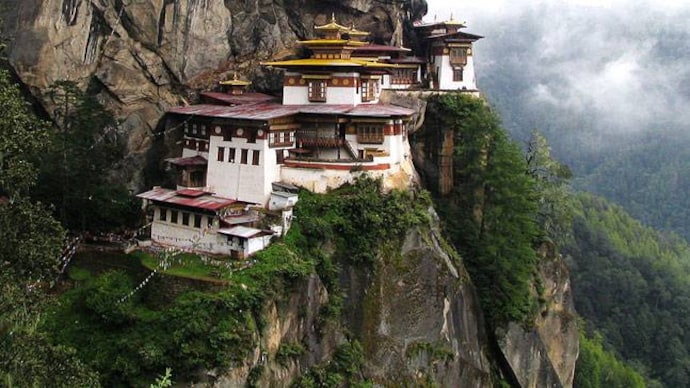10 incredible Buddhist monasteries around the world
Travel to one of these 10 amazing monasteries located in different parts of the world.

Buddhist monasteries are counted among the most sacred places of worship. Millions of people from different parts of the world flock to these temples of faith in search of peace. We bring you a list of the most amazing monasteries around the world.
Taktsang or Tiger's Nest Monastery, Bhutan
Situated on the edge
of a 900 m cliff, the Taktsang Monastery or Tiger's Nest makes for an
imposing sight, and has been symbolic to Bhutan for sometime now. The monastery can be accessed by road, followed by a two to three hour trek from the parking lot.
According to a legend, Guru Rinpoche flew to this location from Tibet on
the back of a tigress. Since then, Taktsang is considered to be a sacred place where any wild animal can be tamed.
Ki Gompa, Spiti Valley, India

Key Gompa or Ki Monastery is a 1,000 year old Tibetan Buddhist monastery situated prominently on the top of a hill, at an altitude of 13,667 ft. The trail leading up to the monastery has parts of the structure which has gone through several demolitions and restorations. This has resulted in a box-like structure, and the monastery now looks like a fort, where temples are built on top of one another.
Yumbulagang Monastery, Tibet

According to a legend, Yumbulagang was the first ever construction in Tibet and it acted as the palace of the first Tibetan king, Nyatri Tsenpo. Its name means 'Palace of Mother and Son' in Tibetan. Under the reign of the fifth Dalai Lama, the palace became a monastery of the Gelugpa School. Sadly, it went through serious damages and was reduced to a single storey during the cultural uprising, before it was reconstructed in 1983.
Hanging Monastery, China

Suspended dangerously halfway up a cliff, some 75 m above the ground, the Hanging Monastery makes for one of the most extraordinary sights in China. Consisting of a complex of 40 rooms linked together by mid-air corridors and walkways, this remarkable monastery was built in the 5th century AD, and has been 'hanging' there for the last 1500 years.
Taung Kalat, Burma

Built atop an extinct volcano cap, the Buddhist monastery of Taung Kalat is considered to be one of the most magnificent sites in Burma. To reach the monastery, visitors need to climb the 777 steps for reaching the top. The Taung Kalat summit offers a beautiful panoramic view of the place. One can see the ancient city of Bagan and the giant solitary peak of Mount Popa.
Lama Temple, Beijing

The Lama Temple (Yonghe Temple) situated in the northeastern part of Beijing, is one of the largest Tibetan Buddhist monasteries in the world. The temple was built by Chinese emperors who had a deep interest in the Tibetan version of Buddhism. Over the years, many Tibetan and Mongolian monks have lived and taught here. The temple contains a 26 m high statue of Maitreya Buddha carved from a single piece of white sandalwood.
Erdene Zuu Monastery, Mongolia

The Erdene Zuu Monastery is perhaps the most ancient surviving Buddhist monastery in Mongolia. It was built in 1585 by Abtai Sain Khan, at a time when the Tibetan version of Buddhism was introduced Mongolia. Stones from the adjacent ancient city of Karakorum were used for its construction. It is surrounded by a wall featuring 100 stupas.
Thikse Monastery, India

Thikse Monastery is a Tibetan Buddhist monastery of the Yellow Hat sect noted for its similarity to the Potala Palace in Lhasa. The monastery is located at an altitude of 3,600 m in the Indus valley. It is a 12-storey complex and houses beautiful pieces of Buddhist art in the form of stupas, statues and wall paintings. One of the main points of interest is the Maitreya Temple, which was installed to honour the 14th Dalai Lama's visit to the Thikse Monastery in 1970.
Ganden Monastery, Tibet

Ganden Monastery is one of the 'great three' university monasteries of Tibet, situated at the top of Wangbur Mountain at an altitude of 14,108 ft. The other two are Sera Monastery and Drepung Monastery. In 1959, the monastery was completely ruined by the Red Guards and the mummified body of Tsongkhapa, the founder of the Monastery, was burned. Reconstruction of the Monastery has been in progress since the 1980s.
Punakha Dzong, Bhutan

Regally standing on an island between the confluence of the Pho Chhu and Mo Chhu rivers, Punakha Dzong is one of the most picturesque of Bhutan's ancient dzongs. Dzong refers to a structure which is a blend of both fortress and monastery. Every district in Bhutan has a dzong. The Punakha Dzong is joined to the mainland by an arched wooden bridge, and contains many valuable remnants from the days when successive kings reigned the empire from this valley.